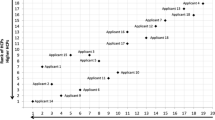Abstract
The most prestigious award in Mexico, the “National Prize for Science and Art” has been awarded to 33 health scientists. An exercise was carried out to assess their performance to answer the question: why them?
The laureates' profile was based on data retrieved from MEDLINE andScience Citation Index Expanded available on the WWW as well as the ISI's 15-year (1981–1995) cumulative impact factor lists. The laureates published 2,049 papers and were cited 50,834 times.
Our results showed the scientific pre-eminence of laureates. We concluded that bibliometric data could complement other indicators of research performance. Bibliometrics could insure the Prize committee against error and the operationalization of the Matthew Effect could be minimized to honor only the most creative researchers.
Similar content being viewed by others
References
H. Zuckerman, Proliferation of scientific prizes reinforces Nobel's distinguished honor,The Scientist, 10(22) (1966), 10.
H. Zuckerman, The proliferation of prizes: Nobel complements and Nobel surrogates in the reward system of science,Theoretical Medicine, 13 (1992), 217–231.
R. Finn, Eponymous prizes honor scientists, but draw criticism,The Scientist, 12(8) (1998), 12.
B. A. Palevitz, R. Lewis, Show me the data: a Nobel lesson in the process of science,The Scientist, 11(24) (1997), 8.
R. Horton, Prizes, publications, and promotion,Lancet, 348(9039) (1996), 1398.
R.K. Merton, The Matthew Effect in science,Science, 159 (1968), 56–63.
J. Ortega Y Gasset,La Rebelión de las Masas. 33 ed. Revista de Occidente, Madrid, 1959, p. 167–168.
S. Cole, G.S. Meyer, Little science, big science revisited,Scientometrics, 7 (1985), 443–458.
N. Wade, No Nobel prize this year? Try footnote counting [online] 1997. Available from: http.www.isinet.com/whatshot/nytimes.html.
Premio Nacional de Ciencias y Artes (1945–1990). Secretaría de Educación Pública, Fondo de Cultura Económica, México, 1991, 509 p.
E. Garfield, Long-term vs. short-term journal impact: Does it matter?,The Scientist, 12 (3) (1998), 11–12.
E. Garfield, Long-term vs. short-term impact: Part II,The Scientist, 12(14) (1998), 12–13.
B. Cronin, J. Licea de Arenas, The geographic distribution of Mexican health sciences research,Scientometrics, 17 (1989), 39–48.
H. Zuckerman, The sociology of the Nobel Prizes,Scientific American, 217 (1967), 25–33.
S. Sri Kantha, The question of nepotism in the award of Nobel prizes: a critique of the view of Hans Krebs,Medical Hypotheses, 34 (1991), 28–32.
Author information
Authors and Affiliations
Rights and permissions
About this article
Cite this article
de Arenas, J.L., Valles, J. & Arenas, M. Profile of the Mexican health sciences elite: A bibliometric analysis of research performance. Scientometrics 46, 539–547 (1999). https://doi.org/10.1007/BF02459610
Received:
Issue Date:
DOI: https://doi.org/10.1007/BF02459610




